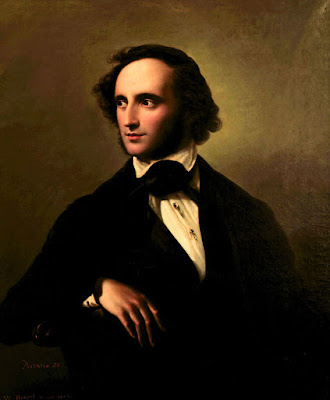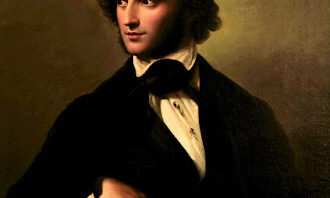 |
| Portrait of Mendelssohn by Wilhelm Hensel, 1847 |
Mendelssohn: Violin Concerto, Symphony No. 2 ‘Lobesgesang’; Lucy Crowe, Hilary Cronin, Nick Pritchard, Orchestra of the Age of Enlightenment, Choir of the Enlightenment, Sir Andras Schiff; Queen Elizabeth Hall
Reviewed 26 April 2024
A near ideal performance of the violin concerto followed by an account of Mendelssohn’s great symphony-cantata that never compromised the work’s idiosyncrasy yet brought out its rich detail and emotionalism
Sir Andras Schiff and the Orchestra of the Age of Enlightenment (OAE) have been celebrating Mendelssohn. It is strange that the effort needs making, but we still have a tendency to downgrade the composer’s symphonic output. Schiff and the OAE, however, have been putting it top dead centre with three concerts at the Southbank Centre‘s Queen Elizabeth Hall which featured all of the composer’s symphonies, two piano concertos with Schiff directing from the keyboard and the Violin Concerto in E Minor with Alina Ibragimova.
We caught the final concert, on Friday 26 April 2024 which featured Mendelssohn’s Violin Concerto in E minor with Alina Ibragimova, and Symphony No. 2 ‘Lobesgesang’ with the Choir of the Enlightenment and soloists Lucy Crowe, Hilary Cronin and Nick Pritchard (replacing Nicky Spence).
We began with Mendelssohn’s Violin Concerto, his last major orchestral work. Conceived for the concertmaster of the Leipzig Gewandhaus Orchestra, the work took Mendelssohn from 1828 to 1845 to write, belying its apparent effortlessness. Schiff used an orchestra based on 33 strings, double woodwind, two horns and two trumpets, quite a large group for a work which can sometimes be given chamber proportions. Alina Ibragimova began with a fine-grained tone, light and fluid playing allied to free phrasing. She never attempted to big-up her tone nor force her way into the spotlight, it all felt somehow effortless and natural, yet compelling and very stylish. In the first movement, there were moments that were daringly intimate, but for all the period manners, there was some very real drama. Schiff encouraged his players to bring out some beautifully vivid colours in the orchestral transition. When the second movement proper, began, it was all singing elegance and fine grained tone. Intimate and delicate, yet with an underlying strength. This delicate approach continued into the last movement, which was delightfully pointed and I loved the sound of Ibragimova’s violin with the wind bubbling along beside her, and the excitement continued to the end. What this performance did was discover a work that was both stronger and more delicate than is often the case, and was notably lacking that sense of saccharine that an over-vibrato-laden violin solo can bring.
Mendelssohn’s Lobesgesang is a strange work, given the number two in the posthumous listing of Mendelssohn’s symphonies it was in fact the third to be written. It is often described as a symphony-cantata, and there are clear parallels to Beethoven’s Symphony No. 9. It was written for the 1840 celebrations of 400th anniversary of the invention of Johannes Gutenberg’s movable type printing system. Mendelssohn sets a series of largely celebratory German texts from Luther’s Bible, and as such the work can also be seen as a celebration of the German language. Luther’s German Bible and its widespread circulation (thanks to Gutenberg’s printing) facilitated the emergence of a standard, modern German language for the German-speaking people throughout the Holy Roman Empire.
Mendelssohn’s choral work had a certain popularity with Victorian and early 20th-century choral societies (there was a standard Novello edition) but has rather died out more recently and performances have become relatively rare. Listening to this one with around 40 choral singers and an orchestra similar to that in the first half (same strings and wind plus two extra horns, and three trombones) you appreciated Schiff and the OAE’s approach. There was a clarity of texture here and whilst the big choral moments had a certain power, it was not at the expense of the immense amount of detail. Mendelssohn seemed to be fond of strong choral textures accompanied by richly busy orchestral lines, and Schiff ensured that everything came over. You can imagine this work, sung by a large choral society and average orchestra, becoming remarkably muddy. Not here.
I was fascinated to see an organ amongst the orchestra, though it never stood out and seemed to be there for choral support only. I wondered what Mendelssohn’s original approach to the organ was, because several of the versions of Baroque choral masterpieces by Mendelssohn and Schumann, including Mendelssohn’s version of Israel in Egpyt, were created because the halls where the large German choirs rehearsed and performed often did not have organs. Discuss!
The opening sinfonia is effectively three movements in one and lasted getting on for 25 minutes, so not a tiny prelude. The opening section, with its use of the motto theme on trombones, tried its hardest to be grand but when it speeded up the result was simply engagingly light on its feet. The next section was almost a waltz, gentle and charming and somewhat unexpected, even though Mendelssohn did try and serious things up a bit by having the wind chorale interrupting things. The final section was quite warm and rather moving.
Then the chorus came in, a strong chorale that developed into a fugue (Mendelssohn had been studying his Bach for some quite considerable time at this point), over vigorously rhythmic orchestral rhythms, Mendelssohn creating a series of strong textures. Towards the end of this movement Lucy Crowe gave us a plangent solo, fluid and engaging with well projected words, all over throbbing wind.
The tenor solo began as a long recitative, where Nick Prichard showed his Bach evangelist chops and projected the words and meaning in striking manner, making it rather moving, leading into a lovely, lyrical, floating aria but still with fine words.
Mendelssohn’s great oratorio Elijah would still be six years away when Lobesgesang was written but both in the solos and the choruses, we kept hearing pre-echoes and the same connective tissues that reoccur in the later work. The next chorus kept flowing yet was full of lovely orchestral details, and this was my one big take-away from this work, the way that Mendelssohn seemed to like a flowing solo line or a strong chorus line with vividly detailed orchestral work underneath and throughout the piece, Schiff and the orchestra had clearly worked hard on shaping and articulating this detail.
A duet for Lucy Crowe and Hilary Cronin was gently flowing, moving from Crowe’s plangently touching solo to two voices interweaving together, complemented by the chorus, the results sounding effortless. Then Nick Pritchard reappeared in a wonderful solo that was vigorous and dramatic, almost operatic. All about the watchman, with repeated calls ‘Watchman, what of the night’, this was full of colours and textures, the drama made even more magical with Crowe’s single radiant line of ‘The night has departed’, leading into a choral celebration, a quasi-Elijah vigorous celebration with the chorus singing with focused tone and clarity, bringing strength and power yet never woolly. The chorale, ‘Nun danket alle Gott’, unaccompanied at first, was clearly a movement of great meaning for Mendelssohn, and led into Nick Pritchard’s arioso accompanied by divided lower strings, small scale yet wonderfully rich. Joined by Lucy Crowe’s more ardent soprano, the resulting duet was only one of the work’s striking moments, particularly the richness of the orchestral accompaniment. The final movement was all the chorus, as they projected vigour and strength, swaggering yet full if character and detail leading to the final climax when the trombone motto returned ‘in excelsis’.
Mendelssohn’s Lobesgesang is rather an idiosyncratic piece yet full of richly imaginative writing and detailed orchestral textures. The way Schiff encouraged his performers to make all this detail finely expressive, to capture the clarity of detail whilst never compromising on the romantic emotional expressiveness of the music was wonderfully engaging and I am not sure that I want to hear it performed in any other way.
Never miss out on future posts by following us
The blog is free, but I’d be delighted if you were to show your appreciation by buying me a coffee.
Elsewhere on this blog
- Fear no more: Brindley Sherratt on releasing his first recital disc – interview
- A German in Venice: Schütz alongside music he could have heard in Venice, a wonderfully life-affirming disc – record review
- Attention must be paid: the Engegård Quartet at Conway Hall in Mozart, Bartok, Maja Ratkje, and Fanny Mendelssohn – concert review
- Opera as it ought to be: Mozart’s Don Giovanni from Hurn Court Opera reviewed by James McConnachie – opera review
- Leeds Lieder 2024
- A Leeds Songbook and a showcase performance: Leeds Lieder Young Artists 2024 – concert review
- A day of French song with a focus on Fauré, with Graham Johnson making us love the composer’s late period, and James Gilchrist in fine form – concert review
- Engaging the audience: James Newby and Joseph Middleton in a folk-inspired programme at a cool Leeds café/bar – concert review
- The sound of an image: recent chamber music by New York City-based, Puerto Rican-born composer Gabriel Vicéns – record review
- A City Full of Stories: Anna Phillips on her work with Academy of St Martin in the Fields’ SoundWalk – guest posting
- Energy, discipline, & sheer love of music-making: National Youth Orchestra & National Youth Brass Band in Gavin Higgins – concert review
- No boundaries or rules: Yorkshire-based Paradox Orchestra is reinventing the orchestral concert – interview
- Full of good things: Sean Shibe and the Dunedin Consort in John Dowland, a new Cassandra Miller concerto and much else besides – concert review
- A little bit of magic: Victoria’s Tenebrae Responsories sung one to a part at the original pitch by I Fagiolini and Robert Hollingworth – record review
- Home










